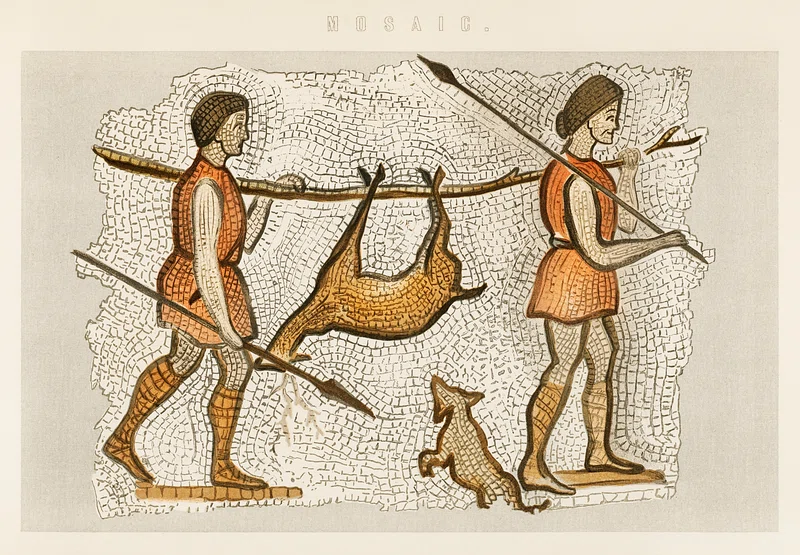Prehistoric India Notes

- The Chalcolithic site in India where the dead were buried under house floors in a North to South position is in — Maharashtra.
- A common feature of Megalithic burial customs is the presence of — copper, bronze, and gold objects.
- The Sohan Culture refers to the — Paleolithic culture.
- Charred and carbonized grains of wild rice embedded in burnt clay walls of huts were discovered at the Mesolithic site of — Bhrigukachchha.
- The microlith industry is rooted in the upper Paleolithic industries because — archaeological findings continued from the upper Paleolithic into the Mesolithic.
- The use of Iron begin in the Indian subcontinent — around 1500 - 1000 BCE
- The archaeological site Daimabad of the Indus Civilisation is situated on the banks of the — Pravara
- North-Western India does not have any middle Paleolithic age sites because adjoining tools are not available in — Punjab.
- The earliest Neolithic settlements in South India are ash mound types because — ash mounds result from burning forests for agriculture.
- The Agrahara in early India refers to —- a village or land granted to Brahmins.
- The practice of burying pet dogs with their masters was found in Neolithic India only in — Kashmir.
- The first to paint their pottery were the — Chalcolithic people.
- The site providing the earliest evidence of animal domestication is — Bagor in Rajasthan.
- Sites like Nevasa and Inamgaon show continuity between the — iron and Chalcolithic phases.
- The Neolithic site of Gumla is located in — North West Frontier Province.
- A characteristic feature of the East Indian Neolithic is that it is based on — rice.
- The river along the most Chalcolithic cultural sites were found is — Tapi.
- Neolithic people are characterized by — never venturing far from the hills and producing just enough for basic subsistence.
- Megaliths are — prehistoric burial monuments.
- Pottery first appeared in the Neolithic phase because — several settlements were acquainted with the cultivation of cereals.
- The original name of Ahar is Tambavati because — people of Ahar practiced smelting and metallurgy from the very outset.
- Chalcolithic people domesticated cattle/sheep/goats, and were gathered in their courtyard because —- domesticated animals were milked for milk and dairy products.
- The internal pattern of settlements and burial practices suggest the beginning of social inequalities in Chalcolithic society because —-chiefs living in rectangular houses dominated others living in round huts.
- Banas culture also known as — Ahar culture
- Gilund was a regional center of Ahar, had a stone blade industry, and Ahar used — microlithic tools.
- Concrete upper Paleolithic art objects have been found at — Patue and Lohanada Nola.
- Ganeshwar, the Pre-Harappan Chalcolithic site that supplied copper objects to Harappan sites, is in — Rajasthan.
- The most completely excavated Mesolithic site in India is — Bagor.
- Buddha Pushkar Lake was an ideal region for Middle Paleolithic people because — good stone was found in close proximity to a permanent sweet water source.
Update Question
Latest RRB NTPC Updates
Last updated on Feb 13, 2024
The RRB NTPC Notification 2024 is expected to be released soon. The RRB NTPC exam is conducted to fill up Non-Technical Popular Category posts. The candidates with successful selection under RRB NTPC get a salary ranging between Rs. 19,900 to Rs. 35,400. here.
Free Books
See AllPremium Books
See AllMORE questions from
-
(Q1)
The branch of horticulture which deals with the production, storage, processing and marketing of vegetables is called
-
(Q2)
Which of the following are metalloids?
-
(Q3)
Which of the following is the correct chronological sequence of pre-historic period of human activities and civilization?
-
(Q4)
Which of the following does not come under the three major periods of the Stone Age?
-
(Q5)
Where in India, would you find rock painting dating back to the Stone Age?
-
(Q6)
When were the caves of Bhimbetka discovered?
-
(Q7)
Bhimbetka caves are located in
-
(Q8)
Rock shelters of Bhimbetka is famous for which of the following?
-
(Q9)
Bhimbetka's caves are considered to be years old.
-
(Q10)
What were the first wheels made of?
Suggested Test Series
View All >No quizzes available at the moment. Please check back later.